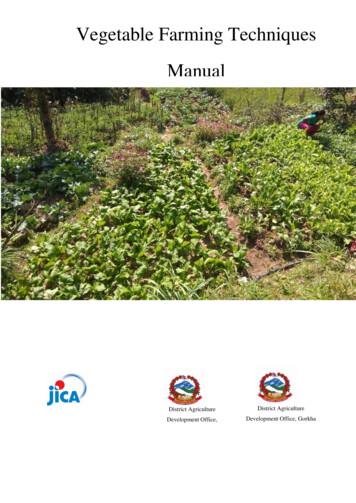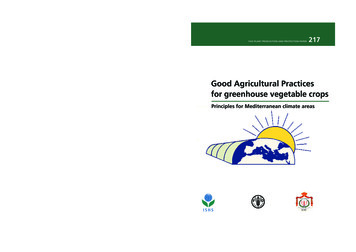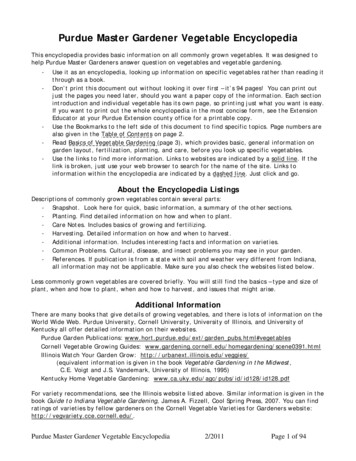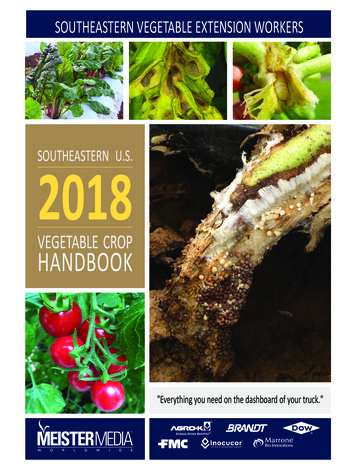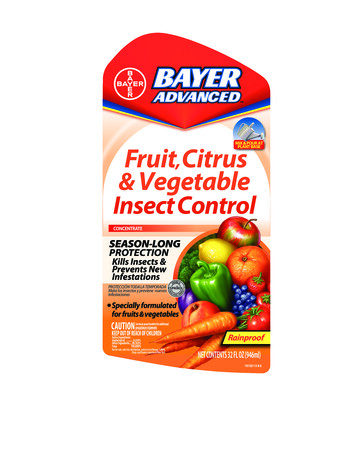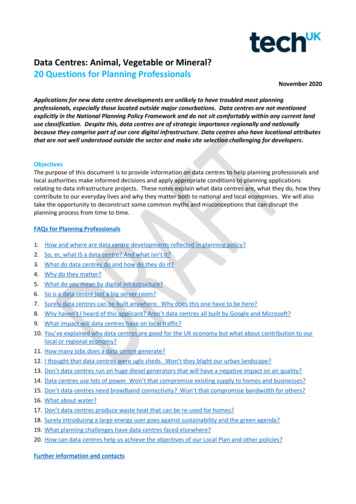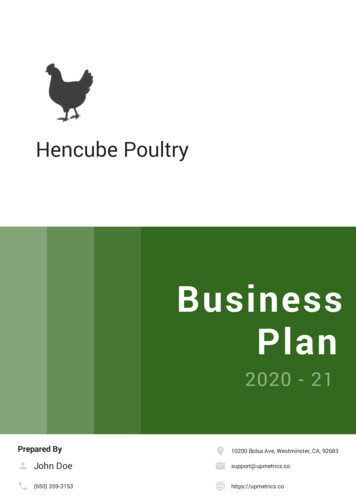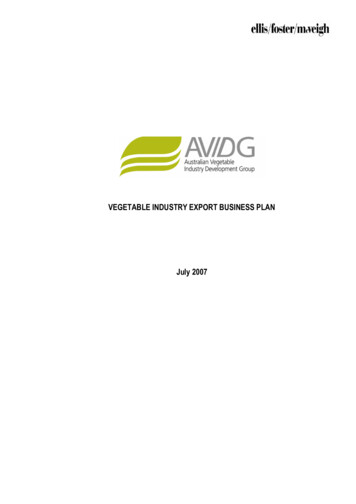
Transcription
VEGETABLE INDUSTRY EXPORT BUSINESS PLANJuly 2007
ContentsAcknowledgements . . 31.Executive Summary. .42. Background to the Vegetable Industry Export Business Plan . 83. Objectives. . .134. Current situation . .145. Strategies and Actions . .20Strategy 1: Vegetable Industry Export Network (VIEN) . 22Strategy 2: International market and competitive analysis . 28Strategy 3: Test the transferable analysis framework . 32Strategy 4: Prioritise and scope future market and competitive analysis initiatives. 33Strategy 5: Future branding, promotion and education implications . 356. Strategy, Action, Timelines and Budget Summary . .38Notes to Strategy, action, timelines and budget summary . 397. Project and corporate risk management .407.1 Project agreements and management . 407.2 Research methodology . 407.3 Development of Recommendations . 408. Communication Plan. .419.Appendices . .44Appendix 1: VIEN member profiles . 45Appendix 2: Global comparative analysis brief – China . 481.1 Milestone. 55Consultation . 55Project Reporting . 55Appendix 3: Global comparative analysis brief – Japan . 56Milestone. 63Consultation . 63Project Reporting . 63Appendix 4: Draft transferable Competitor and Market Analysis framework64AVIDG Export Business PlanPage 2
AcknowledgementsThe input, advice and observations from the following parties during the preparation of this ExportBusiness Plan are gratefully acknowledged. Vegetable Industry Export Network (VIEN) members: Dene Lampard (Centre West Exports), NigelCarey (Webster Fresh), Phillip Jauncey (Matilda Fresh Foods), David Depaoli (Austchilli), SeanLimbrey (Momack), and Neil Armstrong (Harvest Moon); VIEN stakeholders and observers: Craig Johns (National Food Industry Strategy), Lucy Keatinge(Horticulture Australia Limited), Andrew McDonald (Department of Agriculture, Forestry, Fisheries),Jess Darmody (Department of Agriculture, Forestry, Fisheries) and Nick Tana (Sumich Group); Australian Vegetable Industry Development Group (AVIDG) members: Richard Bovill, MichaelBadcock, Peter Cochrane, Wendy Erhart, John Mercer, Sergio Cannale, Ian Pavey, Ian Robinson,and Nigel Steel Scott; Stephen Winter, HAL - Horticulture Market Access Co-ordinator; Ian James, AUSVEG; Peter Walker, Riversun; Laurie Smith, Austrade - Regional Director North East Asia, and Lyndal Jack, Austrade – NationalManager Food and Beverage; Suzanne Laing, Cox Inall Communications; Jeanine Crowther, AQIS – Manager Horticultural Exports Section; Brian Ramsay and Simon Drum (AVIDG Project Managers), Concept Consulting Group; David Aisentros of Apis Business Services; and Phillip Hudson, Paul Van Dee Lee and Neil Howells of Hudson Howells.AVIDG Export Business PlanPage 3
1. Executive SummaryThe Australian vegetable industry is facing unprecedented international competition in globalvegetable markets that threatens its very survival. The combination of uncompetitive terms of trade,in terms of the high Australian dollar, and the emergence of low cost, high volume internationalcompetitors, particularly China, has left the Australian industry at a cross roads. The industry hasseen a reduction of fresh chilled and processed vegetable exports of some 25% in the four years to2006 and an increase of foreign imports into the Australian domestic market of 35% over the sameperiod.Over the last four years alone, China’s burgeoning vegetable industry has increased its market sharein the key Australian export markets of Japan by 14%, Singapore by 8% and Malaysia by 16%. Overthe same period Australia’s market share in Japan has decreased by 1.5%, by 7% in Singapore andby 15% in Malaysia, with these markets all but disappearing for Australian exports if the same rate ofdecline continues for the next four years. The Australian vegetable industry’s negative terms of tradewith China (Australian exports of fresh, chilled, frozen and processed vegetables to China less importsfrom China) has doubled from over - A30m in 2002 to over - A60m in 2006. While the largest sourceof imported vegetables in Australia is New Zealand, Australian vegetable exporters are still performingwell in that market1. In contrast, the declining terms of trade with China (which is rapidly becoming thesecond largest source of imported vegetable products in Australia), together with the facts that Chinais the world’s largest vegetable producer accounting for 49% of global production and growing at 9.1%per annum2, presents stark evidence that Australian producers are under siege in their own domesticmarket.Left unchecked the Australian vegetable industry’s competitive position will continue to diminish to theextent that growers and exporters will increasingly compete among themselves for dwindlinginternational and domestic market share. Ultimately they may not be able to compete with theChinese: the A2.35 billion gross value of production of Australian vegetable producers and regionalproduction and processing businesses, together with the employment and regional economic activitythey generate will be at risk of being lost to those regions, the industry and the Australian economy asa whole.12‘AVIDG Market information audit – vegetables and China’, Hudson Howells, May 2007, p.29‘AVIDG Market information audit – vegetables and China’, Hudson Howells, May 2007, p.43AVIDG Export Business PlanPage 4
Despite these concerns and challenges, desk research suggests that there are still niche market,product development and supply chain integration opportunities in existing and new export markets.The Australian vegetable industry is in a position to exploit these opportunities provided it is preparedto address a range of strategic challenges - from collaborative international market and competitiveanalysis, through internal communication and export policy formulation, to potential new marketdevelopment and global promotion of the features of Australian vegetable products.This export business plan presents a way forward for the Australian vegetable industry to embrace theinternational competitive forces it faces through a sequence of integrated strategies and actions thatprovide a basis for the industry to meet the four key objectives of this plan:(a) Establish and resource a permanent Vegetable Industry Exporters Network (VIEN) focused on:export policy development: advice to the Peak Industry Body and government on investmentpriorities; international competitor analyses, market research and development efforts; andindustry communication and coordination with respect to export markets.(b) Improve the vegetable industry’s capacity to compete with China in the domestic and exportmarkets.(c) Develop export markets for Australian vegetable products in China in the medium to long term.(d) Improve the industry’s knowledge and understanding of: competitive success factors in theinternational vegetable industry; short and long term market retention and developmentopportunities; and priority regions for future competitive and market research, promotion andmarket development.In meeting these objectives through the implementation of the strategies outlined in this export plan,the Australian vegetable industry will be in a position to pursue specific commercial opportunitiesduring the first half of 2008. The strategies are based on the results of an independent marketinformation audit and the detailed consideration by the VIEN, a group of Australia’s leading exportersappointed by the Australian Vegetable Industry Development Group (AVIDG) for the purpose ofdetermining how the industry can grow its exports and hence value to the Australian economy. Thisinvolvement and guidance of export industry leaders augers well for the practical implementation andfuture success of this plan.AVIDG Export Business PlanPage 5
The specific strategies underpinning this plan include:1. Formalisation of the Vegetable Industry Export Network2. International market and competitive analysis (initially China, Japan), to identify criticalcompetitive success factors and develop appropriate market retention, entry and developmentstrategies.3. Test the VIEN’s transferable analysis framework in China and Japan for subsequent use by theAustralian vegetable industry in other markets4. Prioritise and scope future market and competitive analysis initiatives and subsequent supplychain and market development conclusions and opportunities.5. Consider future branding, promotion and education implications based on the results ofcompetitor and market analyses.Communication of the results of this plan to industry will be managed through the leverage of valuableand sensitive market information in order to encourage immediate commercial focus on export marketretention, development and promotion initiatives. In line with the AVIDG’s communication planningwith Cox Inall Communications, channels and tools to be used will include industry publications,events and conferences; media releases; case studies and political briefings. Specific targets for thisinformation include all sectors of vegetable supply chains (from horticultural input suppliers,producers, processors, marketers through to consumers); industry media, associations, organisations;and research bodies.This Export Business plan is based on a budget of 683,353 (exc. GST) for funding in the 2007 –2008 financial year to support the plan’s strategies. Following investment of this initial funding, theVIEN itself will be sustained through an annual budget of 97,600 (exc. GST) in order to maintain thefocus on future market and product development opportunities, supply integration possibilities, furthercompetitive and market research activities, together with industry promotion initiatives and exportpolicy development. The VIEN will need to work with the industry to fund these future activities andinitiatives which will be directed by findings from the implementation of strategies 2, 4 and 5.It is envisaged that some of the activities and initiatives to flow from the strategies will be mostappropriately undertaken by individual commercial entities, whilst others will need to be addressed atthe industry-wide level. One of VIEN’s key future roles therefore will be to identify funding sources forAVIDG Export Business PlanPage 6
all future ‘industry’ wide initiatives at the same time as ensuring processes are in place for individualcommercial players to develop identified commercial opportunities.This export business plan is a critical step in improving the export performance of the Australianvegetable industry. The implementation of its strategies will provide the industry with the knowledgeand momentum necessary to achieve Vegvision 2020 objectives. This implementation will beoverseen by the VIEN as it continues its role of directing, resourcing and overseeing these initiativeson behalf of the Australian Vegetable Industry.AVIDG Export Business PlanPage 7
2. Background to the Vegetable Industry Export BusinessPlanThe Australian vegetable industry is facing considerable competitive challenges to its position in theinternational market place. Over the last decade Australian vegetable exporters have experiencedloss of market share in established export markets, especially in South East Asia, to intense lowercost competition from a number of international competitors. The strong Australian dollar hasexacerbated these competitive challenges. At the same time imports of highly competitive fresh andprocessed vegetable products have increased significantly thereby substituting home grown productin the Australian domestic market.Australian Vegetable Industry Development GroupIn March 2006 the Hon Peter McGauran MP, Minister for Agriculture, Fisheries and Forestry,appointed the Australian Vegetable Industry Development Group (AVIDG) to advise him and hisdepartment (DAFF) on the investment of Commonwealth funds to implement the se
Stephen Winter, HAL - Horticulture MarketAccess Co-ordinator; . This export business plan presents a way forward for the Australian vegetable industry to embrace the international competitive forces it faces through a sequence of integrated strategies and actions that provide a basis for the industry to meet the four key objectives of this plan: (a) Establish and resource a permanent .

